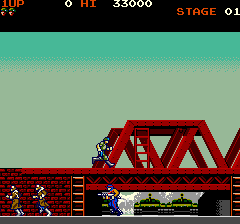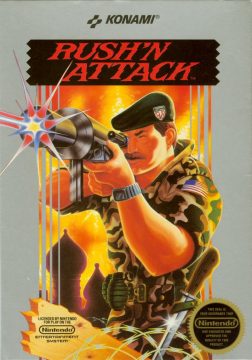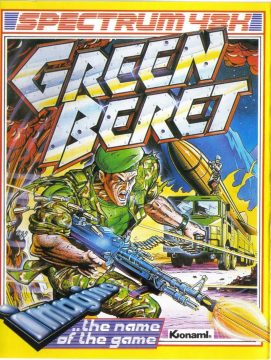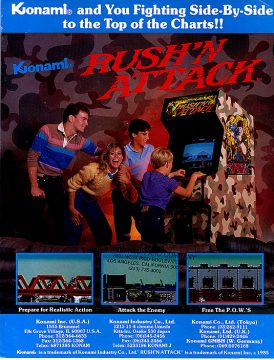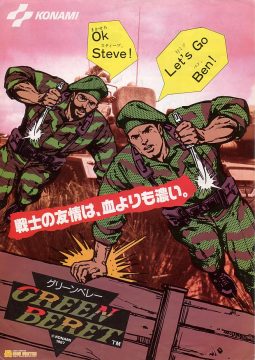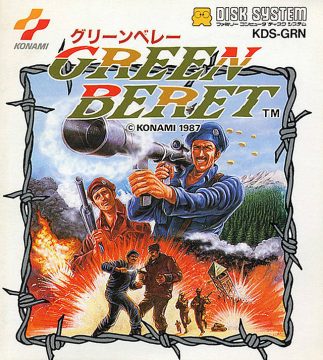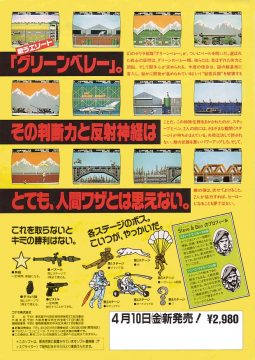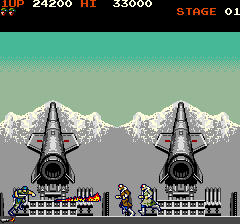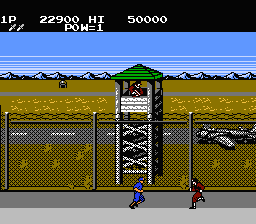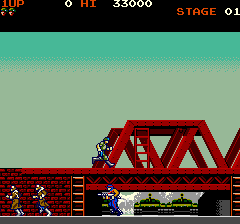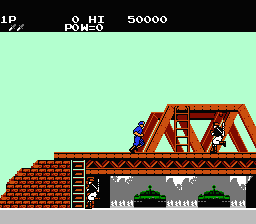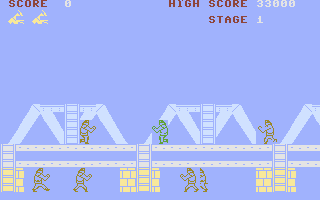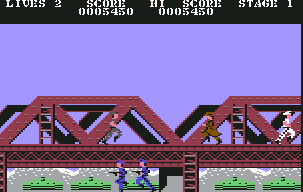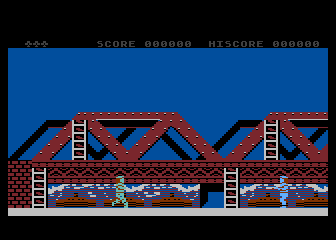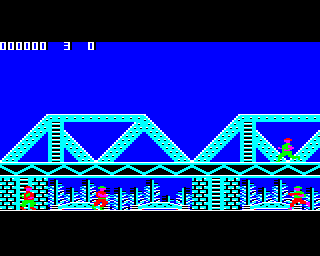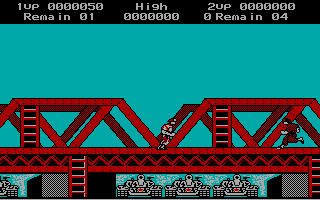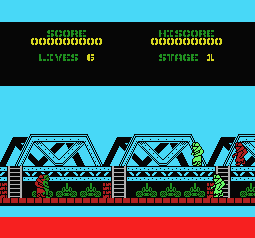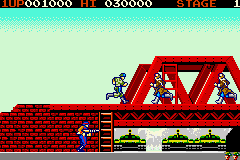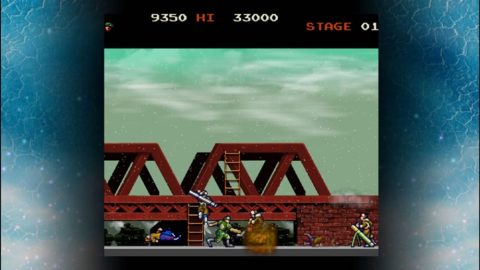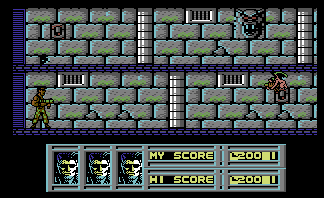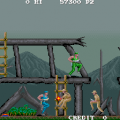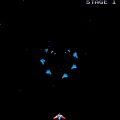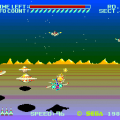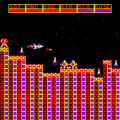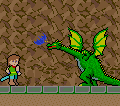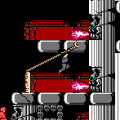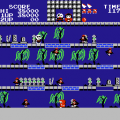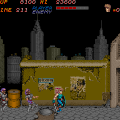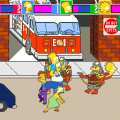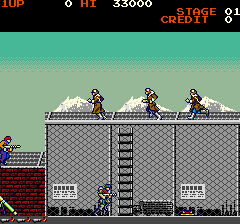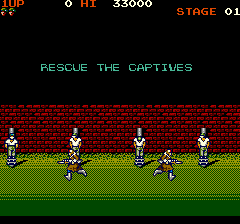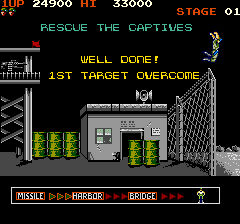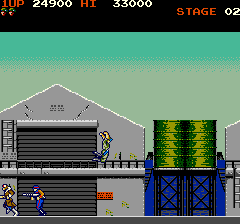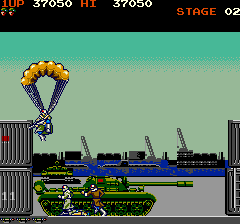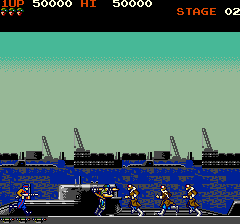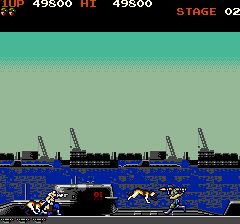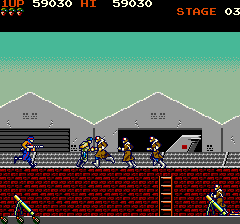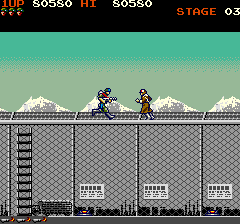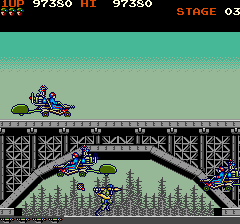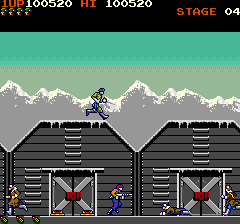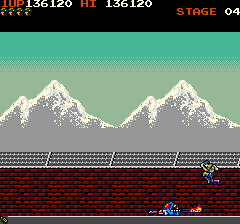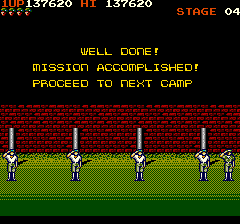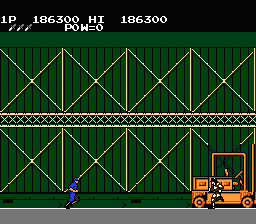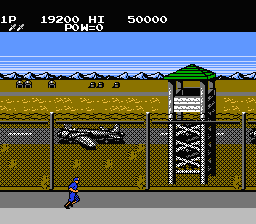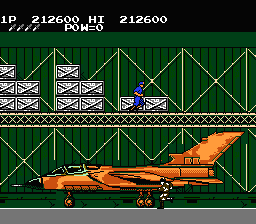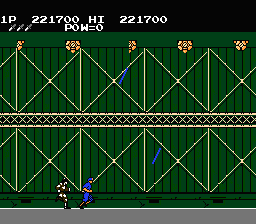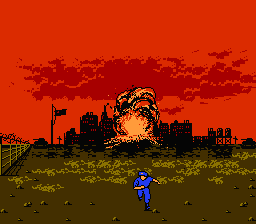Of the many elements of popular culture the 80s introduced, possibly one of the most enduring is the idea of one single man taking down an entire army. Despite the strength of whatever enemy they might be facing, the Iranians, South American dictatorships, or the communists, they all fall to the power of one singular dude. Such is the case with Rush N’ Attack, a game no doubt inspired by the rash of American action movies made in the wake of the Cold War. Much like those movies, while it’s a bit of a short, shallow experience, it’s still pretty enjoyable in its own way even today, should you be a fan of its ilk.
You take the role of an unnamed soldier, sent into a Russian military base to find and free the hostages at the far end of the base. Unfortunately, before you’re even given control of your character, he manages to set off an alarm, instantly bringing the entire Russian military upon him. Apparently, we’re not really looking at the next Snake in action over here. That might not be as much of a problem if your character was packing anything more than a simple knife, while the Russians won’t hesitate in the slightest to shoot or bomb you.
Each of the four stages has you simply make your way from one end of the stage to the other, with no vertical scrolling or even any walls in your way to slow you down. While there are ladders you can climb to reach higher platforms, the fact that enemies will simply follow you upwards means that they’re best use to avoid the occasional set of land mines you’ll come across. The rather barren level design means that your biggest concern is the constant deluge of enemy soldiers that come running towards you from either side of the screen. As you make your way through the base, however, you’ll soon have to deal with new types of foes, like paratroopers who shoot at you from the air, mortar operators who fire arcing projectiles, and martial artists that you’ll have to jump against to stop their deadly jump kick. You’ll also need to be ready for the final assault of enemies at the end of each stage, each of which often brings in a new type of foe to bring with, like swooping gyrocopters, or long range flamethrower wielders.
Despite its relative simplicity, the game’s sheer speed moves at a pretty brisk pace. Every enemy you encounter will die in a single hit, a fair tradeoff for the way the game constantly spawns them without pause. Because of this, you can’t ever really stop moving at any point, lest you end up getting overwhelmed by their numbers. Your knife’s short range doesn’t make things any easier, either, although enemies that actually use ranged attacks against you are somewhat rare. To give yourself an edge, you’ll want to kill the soldiers wearing darker colored uniforms, as they’ll drop special weapons like bazookas, flamethrowers, and grenades. These weapons only carry a few shots each, but they’ll skeletonize a whole group of enemies from a distance, making them pretty useful for keeping yourself safe from the more difficult enemies.
In typical 80s arcade fashion, Rush N’ Attack demands memorization and perfection to clear the game. While the game is fairly generous with checkpoints, running out of lives means starting the game right from the beginning. This means that knowing which enemies will appear in your path and what they can do is vital, as any contact with enemies and their attacks will instantly cost one of your three lives. About the only thing about that feels truly unfair is the fact that you jump by pressing up on the joystick, which can lead to accidental deaths every so often while trying to climb ladders. Despite this, the fact that you can finish a loop in somewhere around ten minutes makes it far less frustrating to start again on than other, similar games of its time.
Graphically, the game isn’t quite as impressive of some other games of the time, and its small, faceless character sprites pale a little in comparison with games like Ghosts N’ Goblins. The tradeoff is that it helps the game bring so many foes onto the screen at once without slowing the game down, which is what helps the experience stay so tense. At the very least, each of the stages are pretty distinct, with their own unique backgrounds, like the massive missiles that you’ll run past in the game’s first stage. The main theme, a looping drum cadence, is appropriate enough for the theme, if not particularly memorable, something that could be said for the rest of the game’s various jingles.
The NES version of the game shares the same basic gameplay and structure of the original arcade version, but serves as more of a ‘remix’ than a faithful port. There’s two new stages, featuring new enemies, like snipers in guard towers, as well as a new final battle where you take out the enemy’s missile. There’s been a lot of changes made to make the game somewhat more fair for home consoles, which helps to give the game a more relaxed pacing. Enemies spawn far less frequently, and don’t move quite as quickly, giving this version a somewhat more relaxed pacing. It’s rare that you’ll have more than three character sprites on screen, and when it does happen, particularly at the end of a stage, the game starts to flicker badly.
There are some welcome new features, however. There’s a new simultaneous co-op mode, a couple of new stages, and a couple of new power-ups. The star gives you a short period of invincibility, while the pistol gives you unlimited shots for a short time. There’s also a new soundtrack, somewhat more in line with Konami’s usual NES soundtracks, making it a little more catchy than the single in-game tune the arcade version offered. It’s not going to be exactly like the arcade version, for better or worse, but it does enough of its own thing that it’s still worth checking out, as long as you can get past the heavy flickering.
The Famicom Disk Version makes a few changes of its own. You now have three continues to finish the game with, dying instantly respawns you instead of sending you to a checkpoint, and enemies only drop one shot for special weapons, but you can carry up to nine shots instead of three.
The Commodore 64 version could have been a decent port for its time, but it has a few issues that keep it from being worth playing. Enemies with firearms give you practically no time at all before they fire, which means you’ll rarely have the chance to crouch under the bullets they shoot. Since this port also spawns soldiers with guns way, way more often the regular grunts, this means that getting anywhere is a matter of luck, since any enemy can shoot you before you can react at just about any point. It’s actually far more difficult than the arcade version, which is a pretty impressive feat. Still, it has some nice exclusive music that plays on its loading and title screens from Martin Galloway, and that alone is worth a listen.
The Spectrum port suffers when it comes to graphics and sound, although its two color pallete means its look ages better compared to some of the more garish games on the system. It also has a difficulty more in line with the arcade version, which makes it far more playable than some of the prettier microcomputer ports.
The DOS version is very much best left avoided, for a multitude of reasons. The jerky scrolling makes seeing what’s ahead of you difficult. This might not be so bad if the controls didn’t have your character constantly moving in whatever direction you press until you hit a button to stop them. All this, combined with the fact that the hit detection feels suspect at the best of times, makes for a pretty unpleasant experience. The only real advantage this port has is offering multiple difficulty levels, but even on the easiest setting, all the game’s faults lead to a very frustrating port overall.
The Atari 8-bit version is almost just as bad, if for an entirely different set of reasons. This particular version gives your knife almost no range, and due to the way it blends in with the background so well, it’s often hard to tell if you’re actually making contact with the enemy soldiers or not. Given that all the enemies move far faster than any other version, you’ll have plenty of moments when you’ll swear you’ll hit a foe, only for them to run right past your knife and straight into you. This version also has the issue where enemies with guns shoot faster than you can react. Some versions of this game make it difficult to escape the first level, but here, it’s an achievement to survive just the first few screens.
The Amstrad CPC version doesn’t do anything blatantly wrong with the source material, although it’s not particularly comfortable to play. The movement feels somewhat chunky, and the flip-screen scrolling that pauses the game and slowly scrolls the next screen into play does a lot to kill any decent flow. It also feels like there’s a slight bit of lag to the controls, which can lead to more than a few annoying deaths. Its chunkier, more colorful sprites make it look nicer than some of the other computer ports, but it has a sluggish feel that’s difficult to ignore.
Given the wonders Konami was able to work with the MSX, you’d imagine its particular port to be, at the least, decent. Unfortunately, none of Konami’s own staff were involved, and it shows. The scrolling in this port is particularly chunky, which gives the game a unpleasantly slow pace overall. The single-color sprites also tend to blend into the background, especially when your character happens to be standing in front of a row of tanks, making him difficult to see. While it doesn’t have as many glaring gameplay faults as some of the other computer ports, it doesn’t feel especially pleasant to play. The fact that this port rapidly flickers colors at you whenever you die doesn’t really encourage further play, either.
The Xbox 360 version offers two modes, with the “Original” mode being a faithful emulation of the arcade game. The “Enhanced” mode smooths out the character sprites, changes the backgrounds to a rendered style, and remasters the soundtrack to give it a more modern sound, but leaves the gameplay of the original arcade version completely unchanged.
The game was featured on the GBA’s Konami Collector’s Series: Arcade Advanced, a collection of several early Konami arcade titles. The compilation features a mostly accurate recreation of Rush N’ Attack, although in some ways, it feels somewhat easier than the original arcade release. This version also has its own separate jump button, making navigating ladders a little easier. Finally, by entering the Konami code on the title screen, two additional levels are added, set on a train and in a hangar. It’s a neat bit of extra effort that doesn’t make the game feel too different, unlike the NES version, and it’s probably the best way to experience the game out of all the possible options.
Konami Classics Series: Arcade Hits</i> for the Nintendo DS also features <i>Rush N’ Attack, along with several other games. This particular version, however, is just an emulation of the original arcade game, with the bottom screen used to display the arcade cabinet’s instruction panel at all times.
Screenshot Comparisons
The Vindicator! – Amstrad CPC, Commodore 64, ZX Spectrum (1988)
While this game is unrelated to Rush N’ Attack or Konami in general, Ocean, in that “enterprising” spirit so common among European publishers of the age, gave reprints of this game the title of The Vindicator! Green Beret II. The title is the only thing the two games share in common, as this game has you as a sunglasses-clad commando, fighting aliens through a variety of different gameplay styles. You start off in a giant 3D maze, occasionally entering rooms where you have to fight an alien. If you get far enough, you’ll also find a scrolling shoot-em-up section, as well as some side-scrolling shooter gameplay. What you won’t find, however, is anything involving Russians and the stabbing thereof. That’s because there’s absolutely no connection. Woe bemongst to the naïve British gamer youth who got suckered.
